
New Items - Illustrations
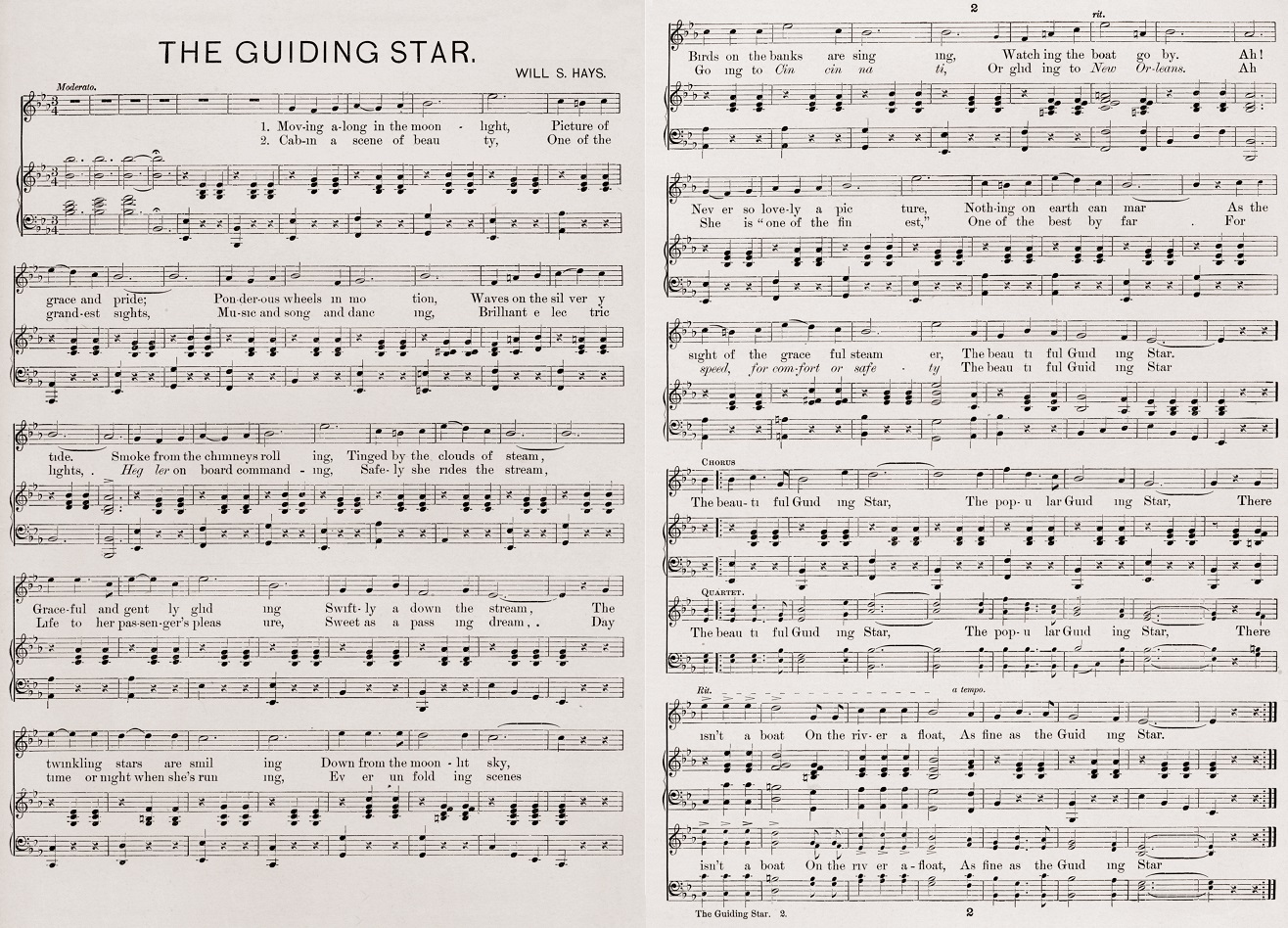
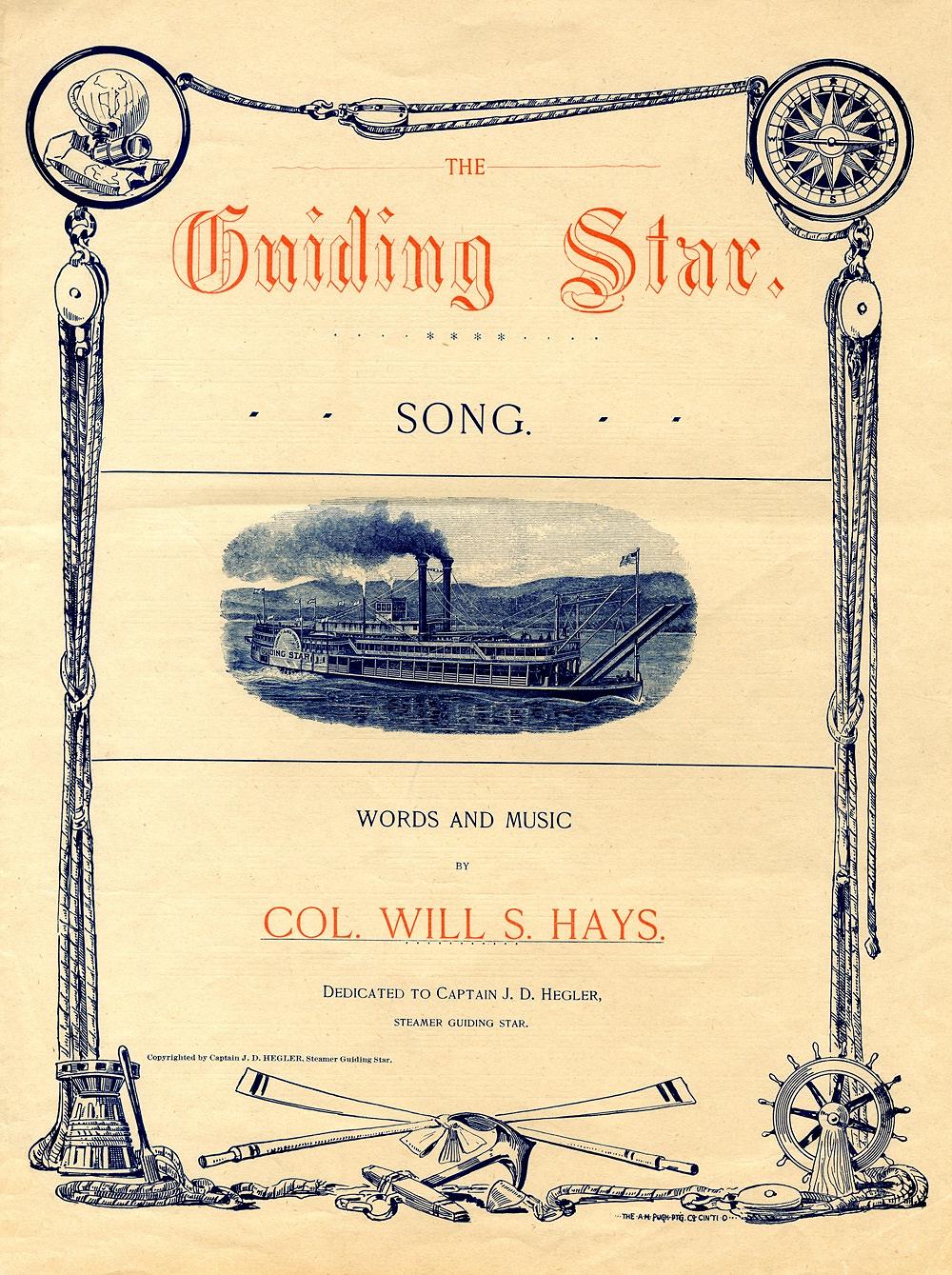
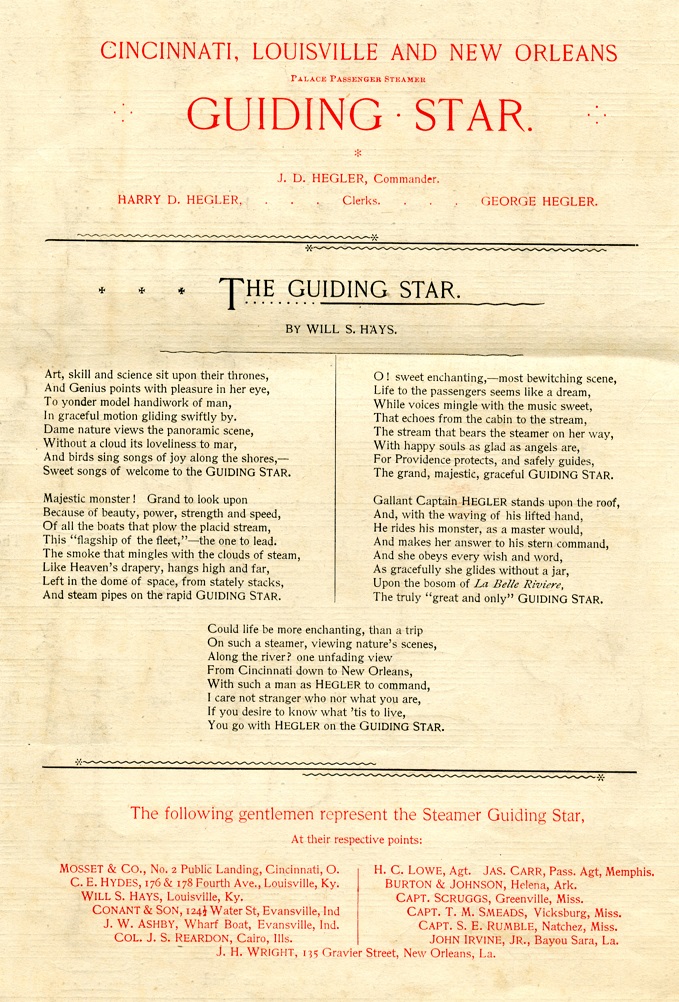
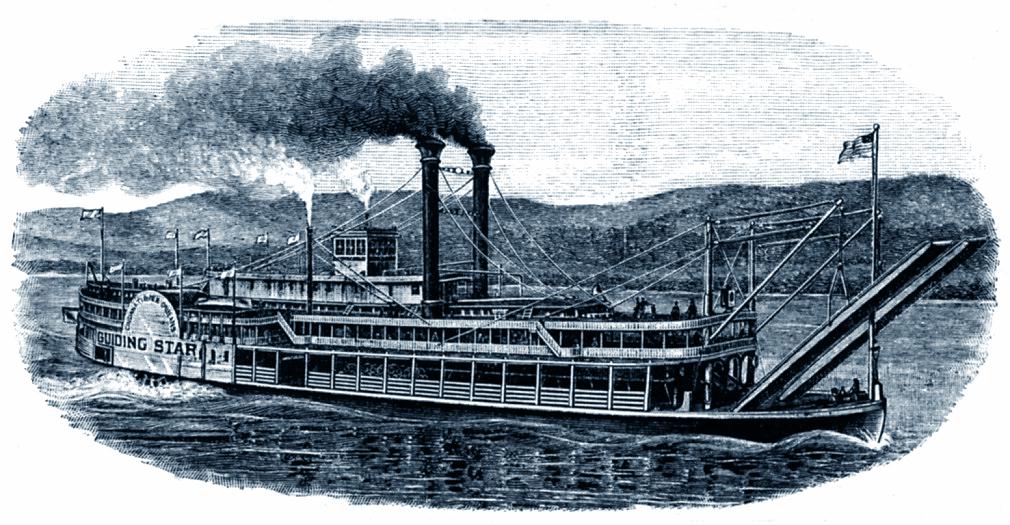
Sheet music dedicated to the Steamboat GUIDING STAR (1878 - 1893) by Will S. Hays
Undated sheet music written by Colonel Will S. Hays in honor of the steamboat GUIDING STAR (1878 - 1893), dedicated to Captain J.D. HEGLER who bought the boat in 1881.
Above are scans of the front & back cover with a song that Will Hays wrote about the boat on the two center pages that contain the music & lyrics. Hays also wrote a poem dedicated to the GUIDING STAR which is included on the back cover. Both the song and the poem are overly romanticized in a florid, antiquated style that is more typical of the first half of the 1800's than 1881 when Hegler apparently commissioned Hays to write this double triple adultation in song, music and poetry after Hegler bought the GUIDING STAR.
Detail of the engraving of the GUIDING STAR from the front cover is also included here.
William Shakespeare Hays (July 19, 1837 - July 23, 1907) was an American poet and lyricist. He wrote some 350 songs over his career and sold as many as 20 million copies of his works. These pieces varied in tone from low comedy to sentimental and pious; his material was sometimes confused with that of Stephen Foster as a result. In his later years, Hays put forth one of the more plausible claims to authorship of the song "Dixie". In the end, however, no evidence could be produced to back up his pretensions.
Hays was born as William Hays in Louisville, Kentucky, which was then a small but rapidly growing city where he would spend most of his life. He published his first poetry in 1856 and 1857 through the paper of his Georgetown, Kentucky, school. Hays eventually received the nickname "Shakespeare" for his writings, an appellation he made a formal part of his name.
Hays finished school and returned to Louisville in 1857. He found employment at D. P. Fauld's music store, where he continued to write music and poetry. He published many of his pieces under pen names, including Syah ("Hays" spelled backward). He also produced three small collections of poetry.
Over his career, Hays is credited with over 350 songs, and he may have sold as many as 20 million copies of his works, making him more prolific than most of his 19th century peers.[2] His songs show a great variety, ranging from austere hymns to base minstrel tunes. In fact, the style of some of his songs was so like that of Stephen Foster that the two men's material was sometimes confused.
Hays was married to Rosa Belle McCullough (1847-1935), and the couple had two children, Mattie and Samuel. Hays died in Louisville on July 23, 1907, less than a week after his 70th birthday. He is buried in Cave Hill Cemetery.
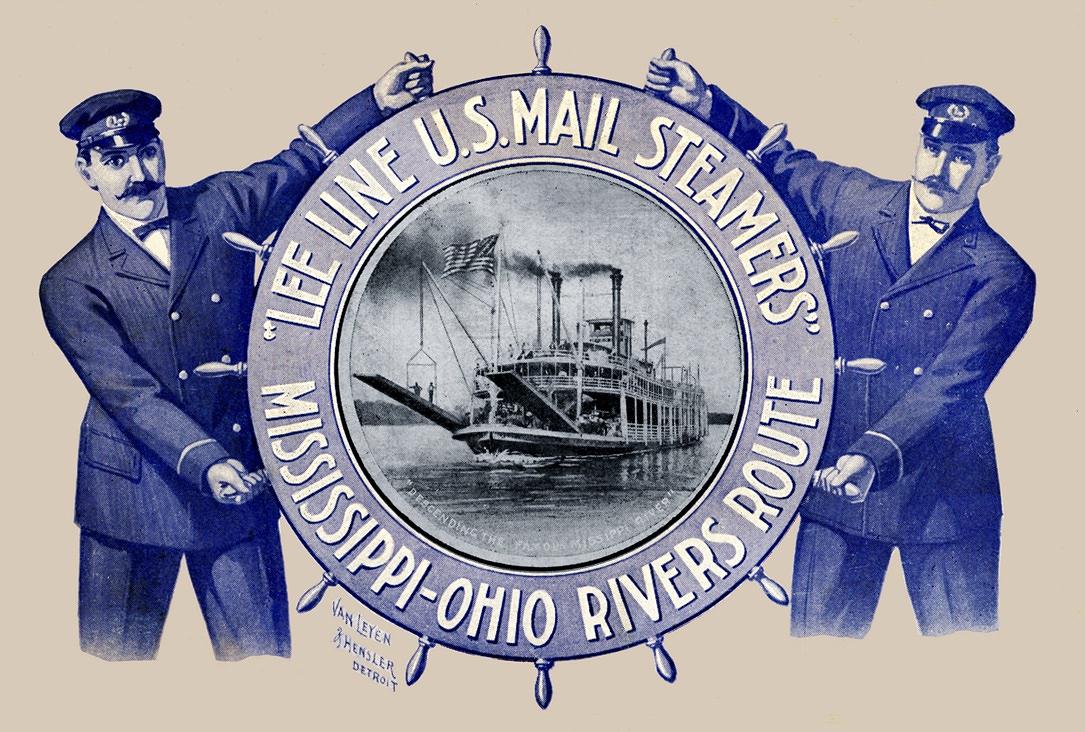
LEE LINE U.S Steamers - Mississippi Rivers Route
Two pilots on either side of a pilot wheel with lettering featured within the curve and a heavily screened photo of what appears to have been the QUEEN CITY.
The Q.C. was printed in a very pale orange color; to increase legibility I boosted the contrast & darkened the image boat graphic, tinting it Navy Blue.
The margins were polluted all around the pilots and the wheel so i bleached them out on a separate exposure and created a beige background to make the presentation more subtle.
Printed by
VAN LEYEN & HENSLER 149 Jefferson Avenue
DETROIT, MICHIGAN
High class designing , engraving, photo-engraving , in half tones in zinc and in wood.
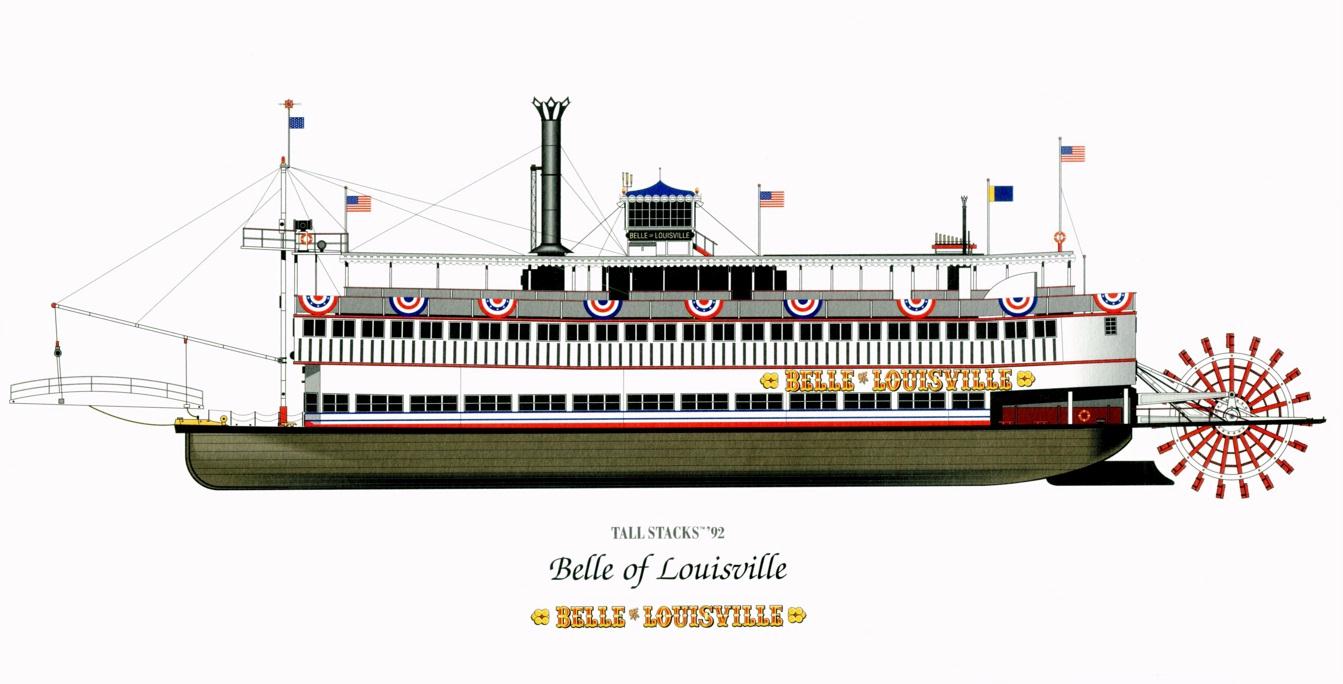
FROM TALL STACKS '92, COLOR PORTSIDE ELEVATION OF THE BELLE OF LOUISVILLE.
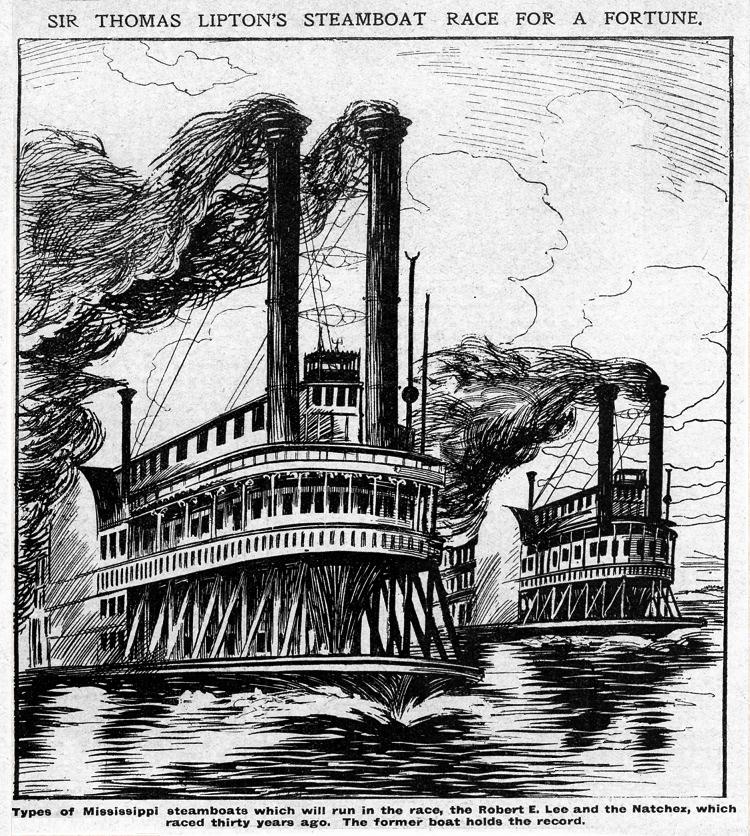
SIR THOMAS LIPTON OFFERS £4,000 FOR A RACE ON THE MISSISSIPPI.
What follows is the text of an article clipping from a British newspaper circa 1900. Sir Thomas Lipton was a wealthy yachtsman and famous for his own "LIPTON TEA."
The pen and ink illustration above accompanied the article. The artist depicted the pilot houses on both boats to be "itsy bitsy" which they wouldn't have been.
Mark Twain is quoted as having made humorous suggestions on how to stage the race in an authentic manner:
A STEAMBOAT STRUGGLE FOR A FORTUNE
SIR THOMAS LIPTON OFFERS £4,000 FOR A RACE ON THE MISSISSIPPI.
Sir Thomas Lipton's interest in aquatic racing has taken a new turn.
His latest sensation is to offer a prize of £4,000 for an old- fashioned steamboat race on the Mississippi River.
He will impose no conditions, it is said, save that the fastest boats on the river shall contest. If the offer is accepted it is understood that the date of the contest will be fixed so as to allow Sir Thomas to attend while on his trip to the United States to "lift the cup." The idea of the race came to Sir Thomas when reading Mark Twain's LIFE ON THE MISISSIPPI, in which the old steamboat races are so graphically described.
The simple love of sport it his sole object in offering the prize. He expects, it is said, to announce his plan in a few days. The race will probably be from New Orleans to St. Louis. The steamboat record between New Orleans and St. Louis is held by the ROB'T E. LEE, which made the trip in 3 days 18 hours and 14 minutes in the famous race with the NATCHEZ thirty years ago. The distance is about 1,2000 miles.
Mark Twain has offered the following suggestions for the forthcoming contest :
"I think that the race should be a genuine reproduction of the old-time race and that it should cover the whole course. I think the boats should start the race at New Orleans side by side (not with an interval between), and end it at St. Louis, a mile or two above the Big Mound.
"I think they should have ample forecastle crowds of negro chantey singers.
"I should reinstate the torch-basket and use the electric light for business only. I would extinguish the Government lights in every crossing throughout the course, for where the boats are equally matched in matters of speed and draught it is the quality of the pilotage which decides the contest.
"Nothing could add to this program except an old-time blow-up as the boats finish in the home stretch. But this should not be arranged; it is better left to Providence and prayer."
The following description of steamboat racing days is from Mark Twain's LIFE ON THE MISSISSIPPI:
"In the flush time of steamboating a race between two notoriously fleet steamers was an event of vast importance. The date for it was set several weeks in advance, and from that time forward the whole Mississippi Valley was in a state of consuming excitement.
" Politics and the weather were dropped, and people talked only of the coming race. As the time approached, the steamers 'stripped' and got ready. Every encumbrance that added weight, or exposed a resisting surface to wind or water, was removed, if the boat could possibly do without it.
"The spars and sometimes even their supporting derricks were sent ashore, and no means left to set the boat afloat in case she got aground.
"Hardly any passengers were taken, because they not only added weight, but they never will 'trim' boat. They always run to the side when there is anything to see, whereas a conscientious and experienced steamboat man would stick to the center of the boat, and part his hair in the middle with a spirit level.
" If the boat was known to make her best speed when drawing five and a half feet forward and five feet aft, she carefully loaded to that exact figure—she wouldn't enter a dose of homoeopathic pills on her manifest after that.
"No freight and no way passengers were allowed, for the racers would only stop at the largest towns, and then it would be only 'touch and go.' Coal flats and wood flats were contracted for beforehand, and these were kept ready to hitch on to the flying steamers at a moment's warning. Double crews were carried, so that alt work could be quickly done.
" The chosen date being come and all things in readiness, the two great steamers back into the stream and lie there, jockeying a moment, apparently watching each other's slightest movements, like sentient creatures; flags drooping, the pent steam shrieking through safety valves, the black smoke rolling and tumbling from the chimneys and darkening all the air.
" People, people everywhere; the shores, the housetops, the steamboats, the ships are packed with them, and you know that the borders of the broad Mississippi are going to be fringed with humanity thence northward twelve hundred miles to welcome these racers.
" Presently tall columns of steam burst from the scale-pipes of both steamers, two guns boom a good-bye, two red-shirted heroes, mounted on the capstans, wave their small flags above the massed crews on the forecastles, two plaintive solos linger on the air a few waiting seconds, two mighty choruses burst forth—and here they come!
" Brass bands bray 'Hail Columbia!" Huzza after huzza thunders from the shores, and the stately creatures go whistling by like the wind.
" Two nicely matched steamers will stay in sight of each other day after day. They might even stay side by side, but for the fact that pilots are not all alike, and the smartest pilots will win the race.
Sir Thomas Johnstone Lipton, 1st Baronet, KCVO (10 May 1848 - 2 October 1931) was a Scotsman of Irish parentage who was a self-made man, merchant and yachtsman. He engaged in extensive advertising for his chain of grocery stores and his brand of Lipton teas.
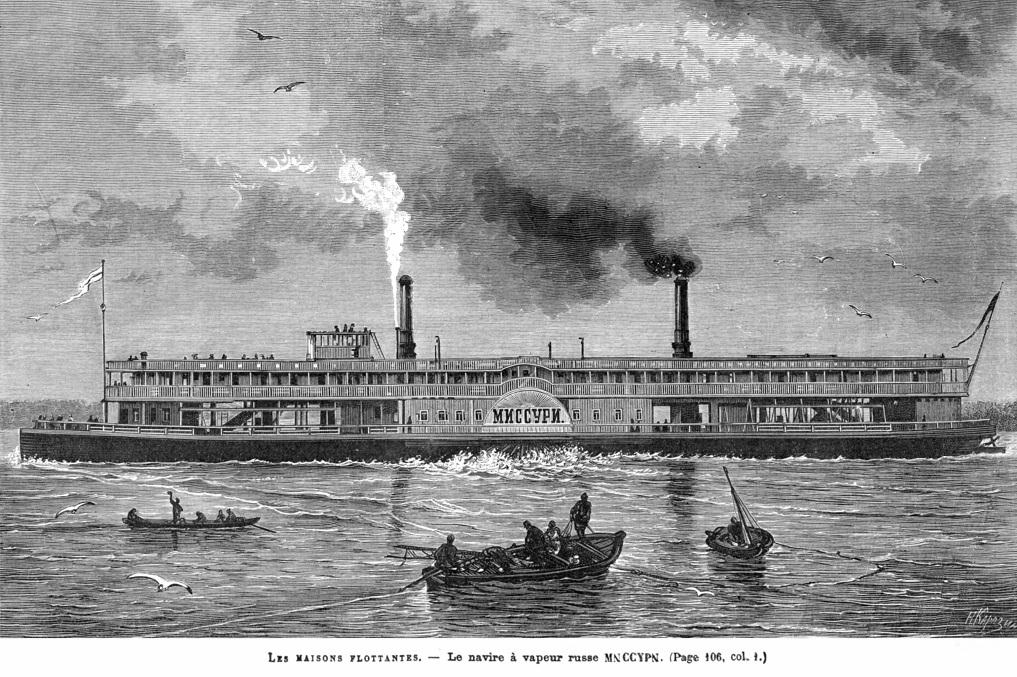
LOATING PALACE named "MISSOURI" on the Volga River in RUSSIA!
This 1881 Russian sidewheeler steamboat мпсъури on the Volga River surprisingly Translates in English to MISSOURI. The attached engraving of the steamboat is from page 105 of a French travel journal and the text below is an approximate translation of the article on page 106 about this Russian steamboat.
JOURNAL des VOYAGES
ET DES AVENTURES DE TERRE ET DE MER
No. 189 20 February 1881
Page 106 Column 1
English translation:
FLOATING PALACES on RUSSIAN RIVERS
Anyone who has not traveled on the great rivers of North America, the Mississippi, the Hudson or the Ohio, and on the immense lakes of this unparalleled country, cannot have an exact idea of what these floating caravans are like - these hotels launched on the water, which often contain on board many passengers, and transport them from one point to another within their country.
The engraving on page 105 represents one of these river vessels which more or less resembles an American steamboat. On board are restaurants, a refreshment bar, a bath, a barber and hairdresser, beds for resting, newspapers and a library. Everything you need to live comfortably during a long or short voyage. There is nothing like these steamships to make those who love travel understand what it takes to manage science and service to achieve the well-being of passengers on board. Steam vehicles intended to travel on the natural canals of the American or Russian countries.
The мпсъури measures sixty-three meters in length, and it has three floors: the hold, and two decks above that. The roof serves as a walkway for sightseers and those who like to enjoy the breeze and stretch their legs.
The hold, between decks, is reserved for the passage of the lower classes and where packages and goods are stored. On the deck above are the dining rooms, the reading room and library. In the bow is the kitchen, in front of that is the café and a bar room.
The parlor of these floating houses is luxuriously furnished and offers passengers comfort which reminds them of home and makes the journey much more pleasant, rather than tiring and difficult. Each bedroom consists of a single or double bed, depending on whether it is intended for a boy, a young girl or a single woman, or for a married couple. Two armchairs, a washbasin, mirrors, coat racks, a chest of drawers. Everything is comfortable so that a passenger need not leave their stateroom if it is stormy outside, but can look out their window, and contemplate the landscape that unfolds before their eyes.
The banks of the Volga, crossed by the steamboat which is represented in this issue of our daily newspaper, are very picturesque. Sometimes there are pine forests or large creeks, under which live bears and deer who come to drink on the banks of the river. Vast swamps are frequented by waterfowl and great eagles, symbols of nationality and the power of tyrants.
Farther from the mountains, hills covered with trees and often a swarm of heather roosters, ptarmigan and other wild fowl. In the waters of the Volga are caught sterlets and sturgeons, these kinds of freshwater sharks whose flesh resembles that of calves, and produce caviar which canning manufacturers prepare from fish eggs preserved in olive oil, which Russians are very fond of. There is no meal that is not served with caviar and ham sandwiches, all of which are intended to induce thirst and encourage imbibers to order drinks.
The fishermen that we see in the foreground of the engraving are busy raising their nets, in which their harvest of fish may be abundant.
B. H. R.
The ptarmigan a northern grouse of mountainous and Arctic regions, with feathered legs and feet and plumage that typically changes to white in winter. The sterlet (Acipenser ruthenus) is a relatively small species of sturgeon from Eurasia native to large rivers that flow into the Black Sea, Azov Sea, and Caspian Sea, as well as rivers in Siberia as far east as Yenisei. Populations of sterlets that migrated between fresh and salt water (anadromous) are now extinct.
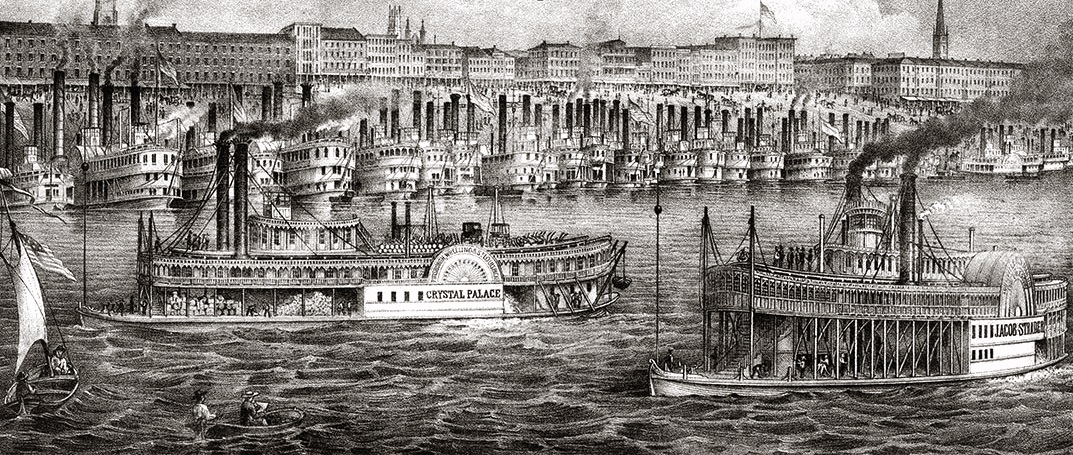
Detail from a unique panoramic view of Cincinnati from the 1850's featuring the steamboats CRYSTAL PALACE & JACOB STRADER that was on display a special exhibit during the Spring & Sumer of 2014.
Covington's Cincinnati Miami University Special Collections
King Library, Room 321, 151 S Campus Avenue, Oxford, OHIO 45056
June 4 - August 1, 2014
miamioh.edu
Cincinnati 1850's panorama with the steamboats CRYSTAL PALACE & JACOB STRADER
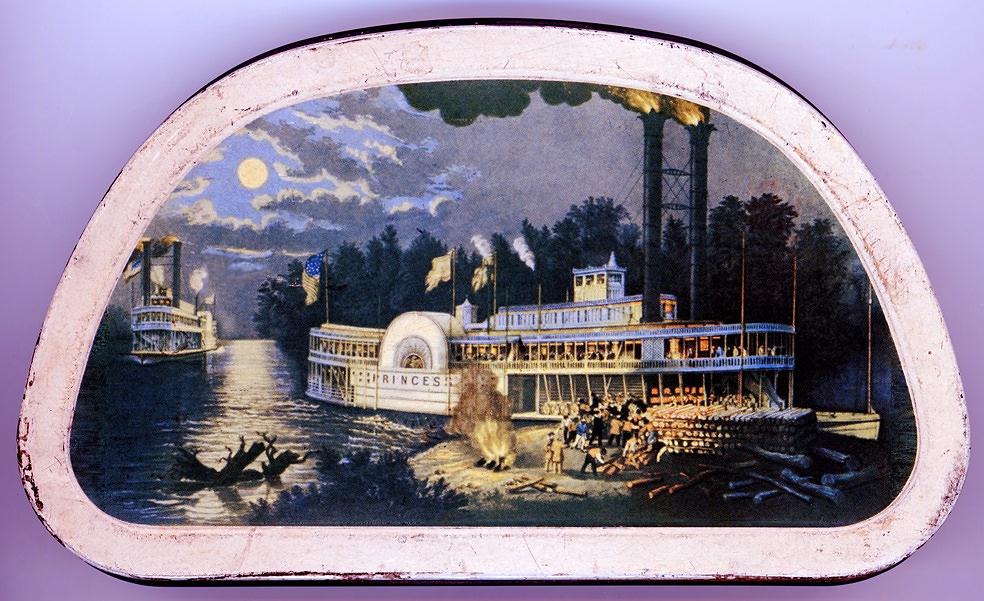
Color lithograph steamboat PRINCESS on a vintage tin box.
Currier & Ives based on the color lithograph of the steamboat PRINCESS wooding up on the Mississippi on a moonlit night.
Printed on a vintage 3-3/4 x 6-1/2 inch tin box which probably contained candy originally. This originated in England.
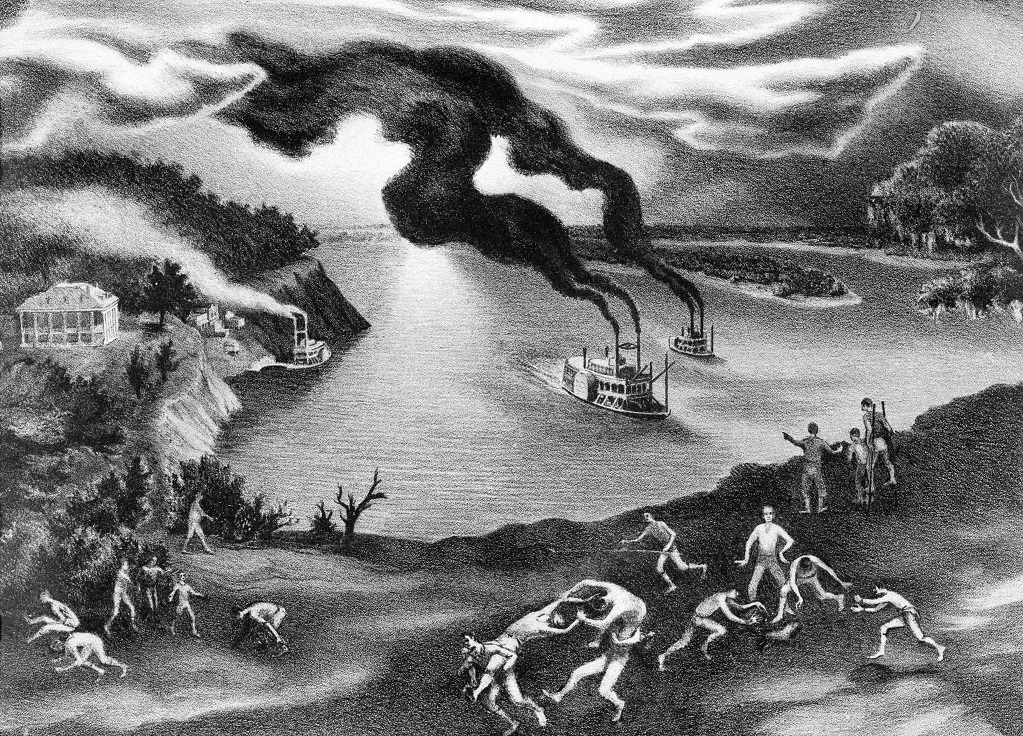
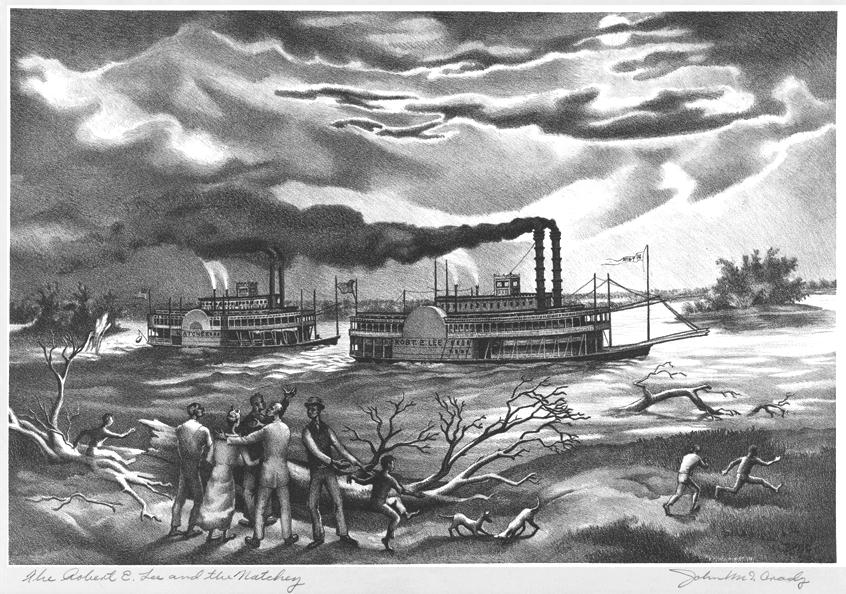
John McCrady: Lithograph of 3 steamboats on the Mississippi River
John McCrady Louisiana artist 1911 - 1968
Steamboat 'Round the Bend, 1944
Not sure if the title was inspired by Ben Lucien Burman's novel, the 1935 movie of the same name or what exactly.
Detail of approximately 75 percent of the lithograph in black that includes 3 steamboats on the Mississippi River and a plantation house on the bluff, far left. In the foreground a bunch of young men are "wrestling"? "horsing around"? "practicing acrobatics"? It's ambiguous.
image: 9 15/16 x 14 3/4 inches
sheet: 13 x 17 1/4 inches
published by Associated American Artists
In 1945 McCrady made a lithograph of the race of the NATCHEZ & the ROB'T E. LEE.
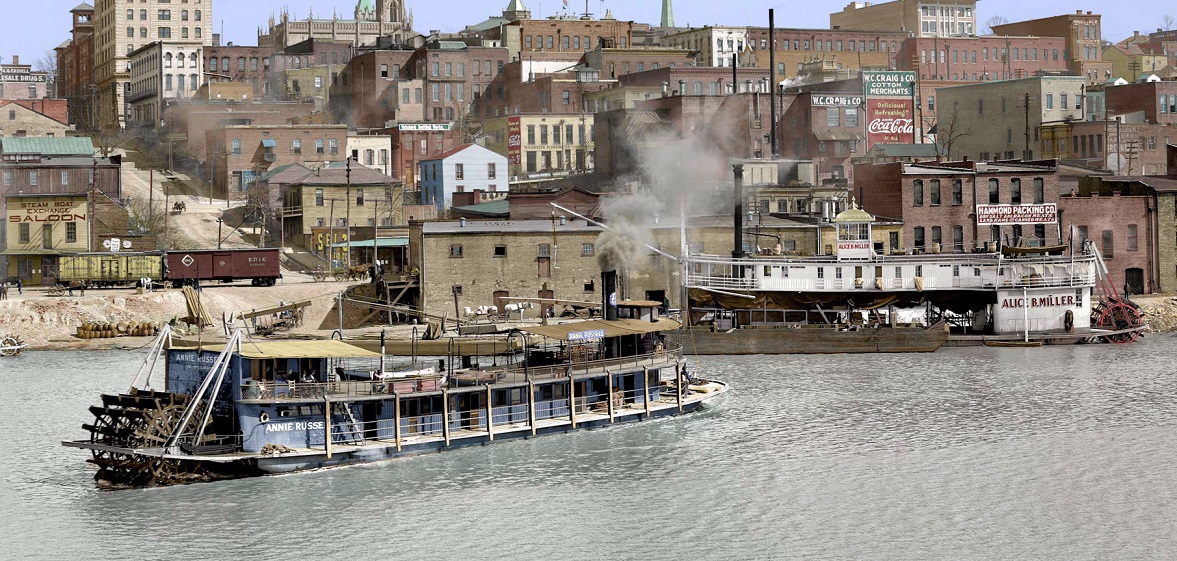
Vicksburg, Mississippi in 1909 with sternwheelers ANNIE RUSSELL & ALICE B. MILLER
Vicksburg, Mississippi in 1909 by Detroit Publishing with sternwheelers ANNIE RUSSELL & ALICE B. MILLER colorized on the SHORPY site of vintage photographs.
ANNIE RUSSELL
Sternwheel Pleasure Boat
Way's Packet Directory Number 0297
Built at Dubuque, Iowa in 1902
125 x 25 x 4.5
Engines 10 - 4 feet
Two boilers 40 inches by 14 feet.
A rim steel hull pleasure craft owned by Russsell Gardner of St. Louis. Musch equipment from the former steamboat ALICE EDNA. The Kansas City - Missouri River Navigation Co. bought her in May 1911, converted her into a single stack towboat name ADVANCE. Federal Barge took her over, transferred her to Mobile, Alabama where she sank. The wreck was raised in May 1928 and junked.
ALICE B. MILLER
Sternwheeler
Way's Packet Directory Number 0152
Originally the FRANK B. HAYNE, built at Jeffersonville, Indiana in 1904. Renamed in 1908 when she was bought by C.J. Miller of Vicksburg who ran her in the Yazoo and Sunflower River trade. Burned on March 26, 1915 at Vicksburg.
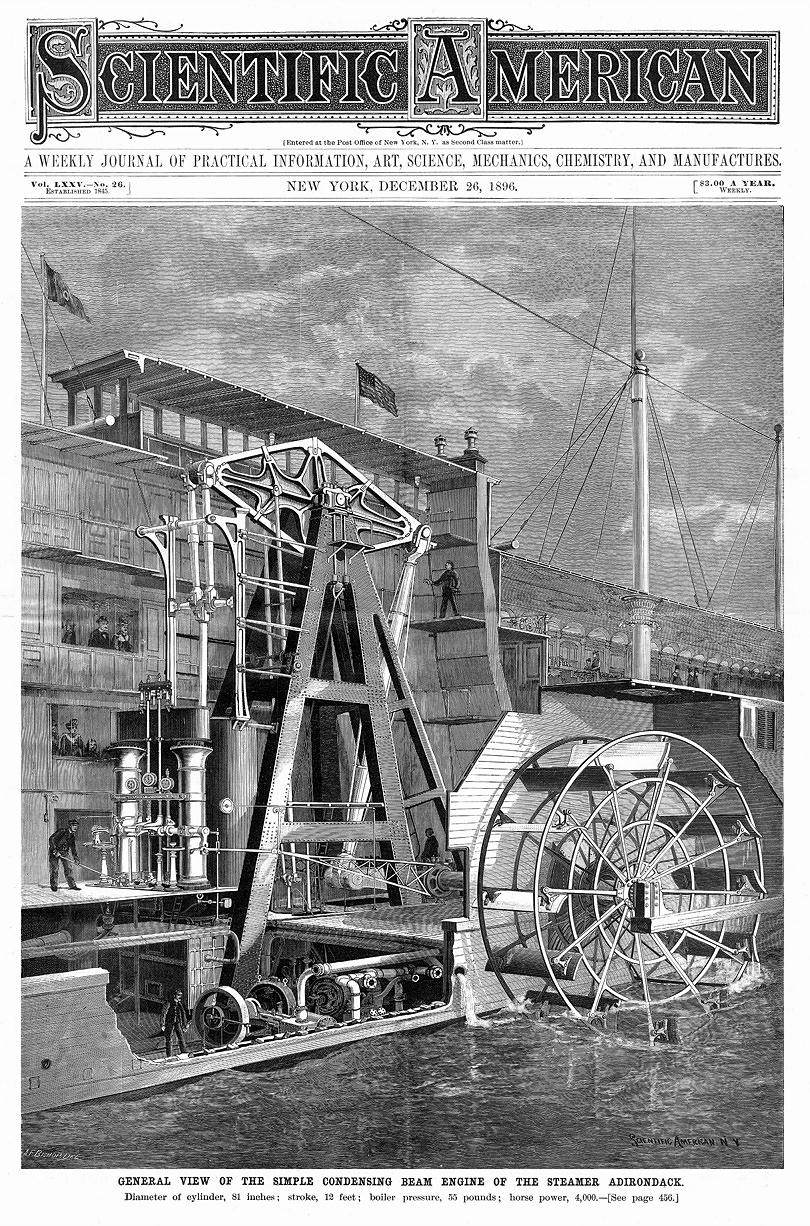
STEAMER ADIRONDACK. Scientific American 26th December 1896
Scientific American
Front Cover
26th December 1896
GENERAL VIEW OF THE SIMPLE CONDENSING BEAM ENGINE OF THE STEAMER ADIRONDACK.
Diameter of cylinder, 8I inches; stroke, 12 feet; boiler pressure, 35 pounds; horse power, 4,000
Steamer "Adirondack", 1896 - 1925
From the HUDSON RIVER MARITIME MUSEUM site
7/24/2020
Editor's Note: The following text is a verbatim transcription of an article written by George W. Murdock, for the Kingston (NY) Daily Freeman newspaper in the 1930s. Murdock, a veteran marine engineer, wrote a regular column. Articles transcribed by HRMM volunteer Adam Kaplan. See more of Murdock's articles in "Steamboat Biographies".
The last and largest of the wooden hull steamboats built for service on the Hudson river- that's the distinction that belongs to the 420 foot "Adirondack".
The "Adirondack" was built in 1896 by John Englis & Son at Greenpoint, for the People's Line, of which John Englis was vice president. She was one of the most handsome and one of the best equipped vessels ever constructed for river navigation, and was a great improvement over the magnificent "Dean Richmond," "Drew" and "St. John." Her hull was built chiefly of wood, the frames were of oak, chestnut, and red cedar. She boasted five decks, the main, saloon, gallery, dome, and the hurricane, and she had 350 staterooms, including 24 parlors and four suites of parlors.
All rooms were furnished with iron and brass bedsteads, and there were also 286 berths in the cabins and 120 berths for the crew. The dining room was on the afterpart of the main deck with a seating capacity for 250 people. The main saloon was decorated in white, green and gold. An electric plant furnished power for 2,000 lights, plus a powerful searchlight mounted on the pilot house which would reveal objects over two miles away. The entire vessel cost well over a million dollars when completed.
The "Adirondack" was known as one of the Hudson river flyers. In May, 1899, she made a remarkable fast run- traveling from New York to Albany with 350 tons of freight and 400 passengers in six hours and 24 minutes actual running time.
The "Adirondack" ran in line with the "Dean Richmond" until the advent of the "C.W. Morse" in 1904. She then continued sailing the Hudson until 1913 when the "Berkshire" replaced her. The "Adirondack" was used as a spare boat until 1915, and then in the summer of 1917 she was commandeered by the federal government and taken to the Brooklyn Navy Yard for the purpose of housing recruits for the war.
At the close of the World War the "Adirondack" was taken up the Hudson river to Athens and laid up. In December, 1925, she sank while laying at the dock and was then sold to a junkman and broken up.
Author George W. Murdock, (b. 1853-d. 1940) was a veteran marine engineer who served on the steamboats "Utica", "Sunnyside", "City of Troy", and "Mary Powell". He also helped dismantle engines in scrapped steamboats in the winter months and later in his career worked as an engineer at the brickyards in Port Ewen. In 1883 he moved to Brooklyn, NY and operated several private yachts. He ended his career working in power houses in the outer boroughs of New York City.
His mother Catherine Murdock was the keeper of the Rondout Lighthouse for 50 years.
Book Covers & Illustrations
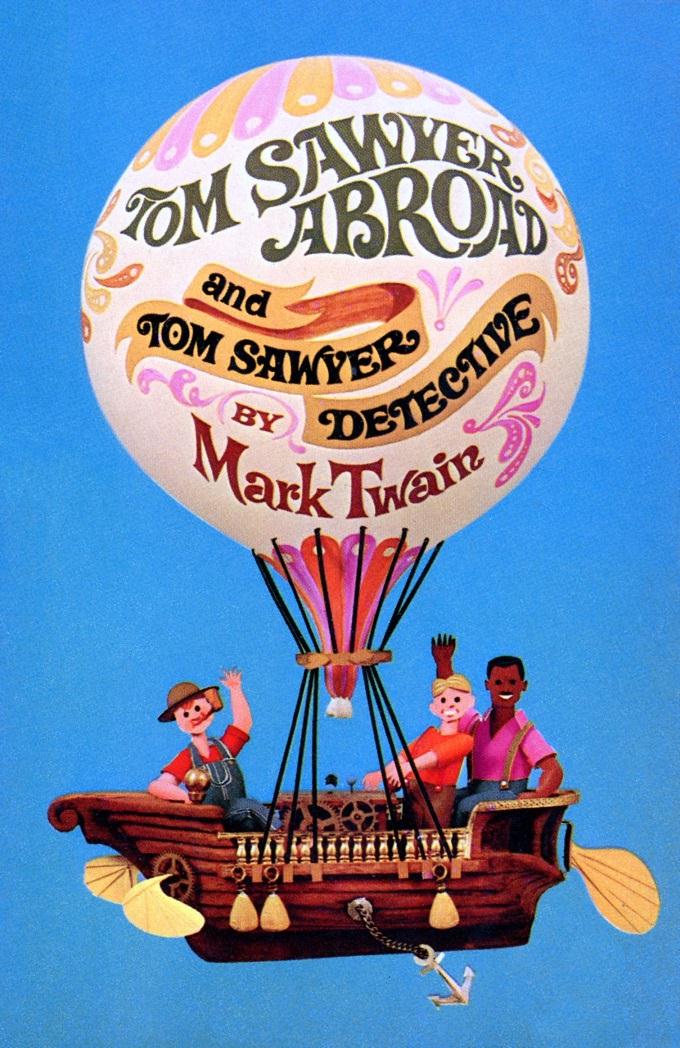
Tom Sawyer Abroad & Tom Sawyer Detective Front Cover Collage by BlakeHampton
THIS WHIMSICAL 3 DIMENSIONAL COLLAGE ILLUSTRATION HAS A LOT OF CHARM TO IT.
Mark Twain's Tom Sawyer Abroad & Tom Sawyer Detective
Front Cover Collage by Blake Hampton
From the Dell paperback edition published in 1965
OBITUARY: Legacy.com
legacy.com
Blake Hampton 6/11/1932 - 2/4/2020 (87 years old)
Blake has gone on to his next adventure from his adopted hometown of Hilton Head Island, South Carolina.
He was a dad, an illustrator, an outdoor-lover and sported an epic handlebar mustache.
Born in Poteau, Oklahoma, he was raised in Dallas, graduated from the University of North Texas and went on to be an art director at advertising agencies in New York City.
He married Lucille Lantelme of New York and together they raised two daughters in Weston, Connecticut.
"Mr. Weston" was involved at Norfield Congregational Church, a volunteer for the ambulance squad and a constable; he designed the town seal and the masthead for the town's first newspaper.
He was a fan of Laurel & Hardy, pro-wrestling and good bourbon; a minister of silly walks and the father all his kids' friends wished they had.
He taught his girls to bird-watch, cheat at mini golf, enjoy the woods, appreciate history and love art.
He could fix almost nothing but was a black-belt at SuperGlue.
Blake moved to Hilton Head with his partner, Susan Mason, in 1995 and was active at First Presbyterian Church, the Rotary and Lion's Club.
He was famous for being the first to volunteer for any given effort and infamous for never being electronically reachable.
He is preceded in death by his parents, Edna Gately and Ivan Wade and his brother Ivan Dan.
Survived by his partner Susan Mason, daughters Caroline Manning (Jim) of Dallas, Danielle of Waitsfield, Vermont and brother James Wadeo Trophy Club, Texas.
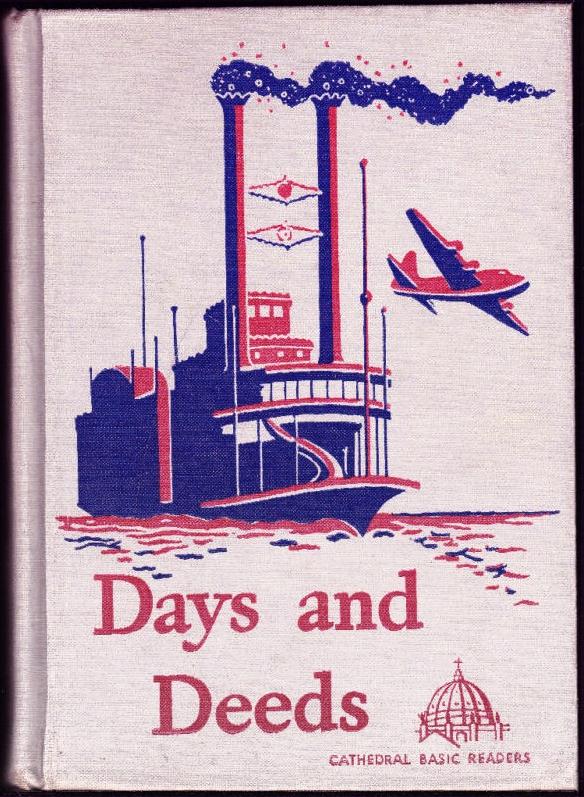
Book Cover Graphic
"Days and Deeds"
Cathedral Basic Readers
(First grade level)
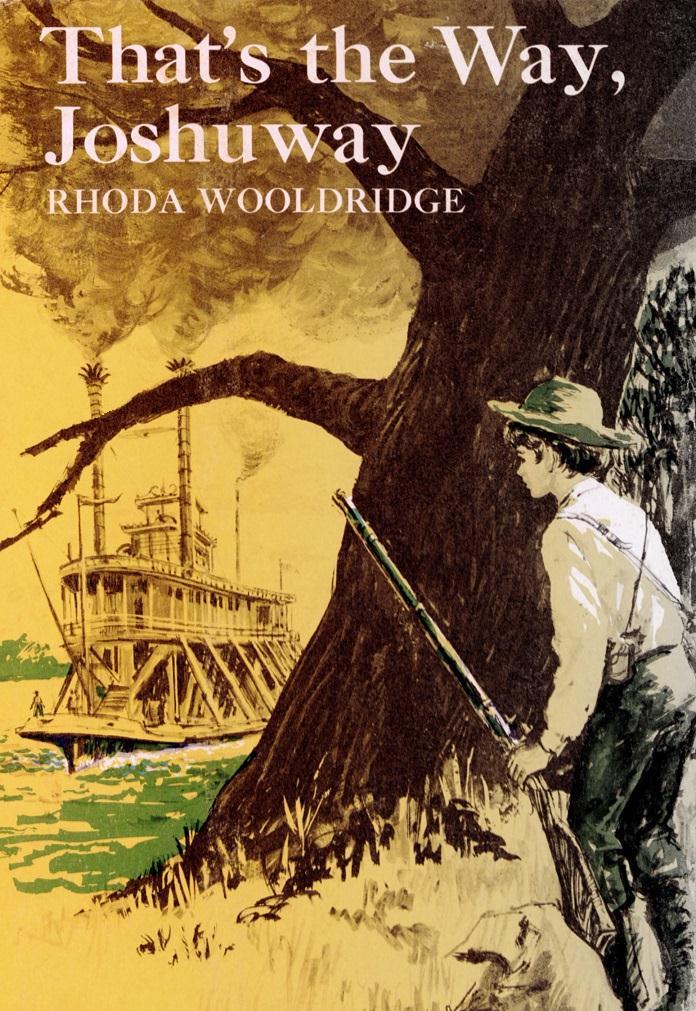
THAT'S THE WAY JOSHUWAY dust jacket art with steamboat
That's the Way, Joshuway
By Rhoda Wooldridge, Rhoda
Dust Jacket cover illustration by Charles Walker
Independence, Missouri
Independence Press, 1965. 152 pages.
(Ages 10-14) Fiction
That's the Way, Joshuway is a fast-moving story set around Arrow Rock, old Blue Mills landing, and Independence, Missouri, during the exciting frontier days when riverboats plied the Missouri River and wagon trains moved westward along the Santa Fe Trail near Lexington and Independence. While Josh Carver's dream of going west is never realized, he does learn the satisfaction of belonging to a family and to a homeland carved in the wilderness of Missouri. He is helped along the way by George Caleb Bingham, the artist whom he had encountered while working in his uncle's harness shop in Arrow Rock. This historical novel reflects familiar scenes across mid-Missouri and describes the life, customs, and people of the 1840s, but its main theme features a young boy's taking pride in his work and learning to become independent while sharing the joys of family life.
That's the Way, Joshuway is especially worthwhile for its realistic setting. Many of the towns and roads in the area have retained the same names, and several buildings, including the entire old town of Arrow Rock, have been restored to their original appearance. The reader who has traveled in this area can readily identify with Joshuway, and all who become acquainted with him can take pride in the historic landmarks that were once so important to this storybook character.
Review by Alice Irene Fitzgerald from "Missouri's Literary Heritage for Children and Youth"
University of Missouri Press
Columbia, Missouri 1981
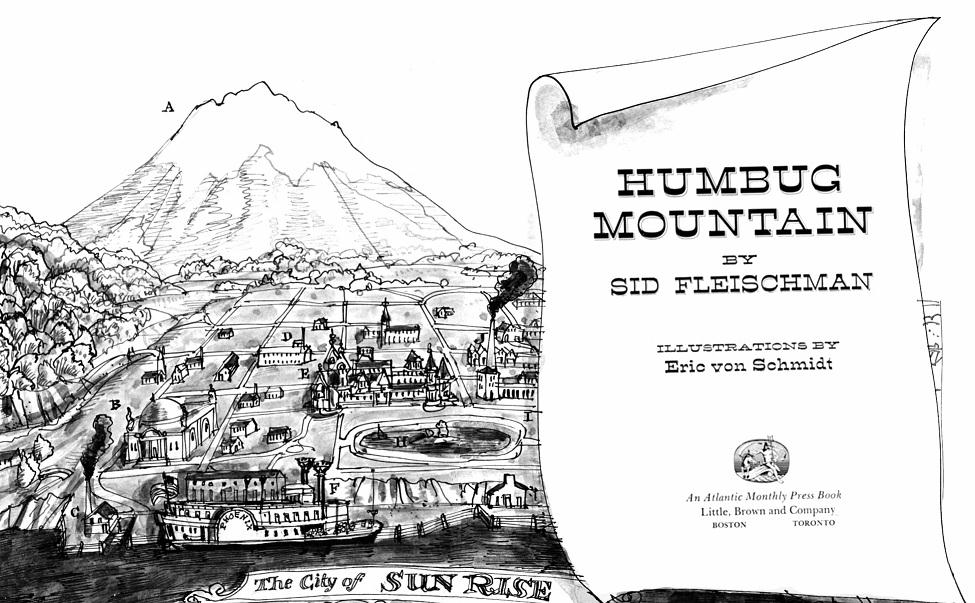
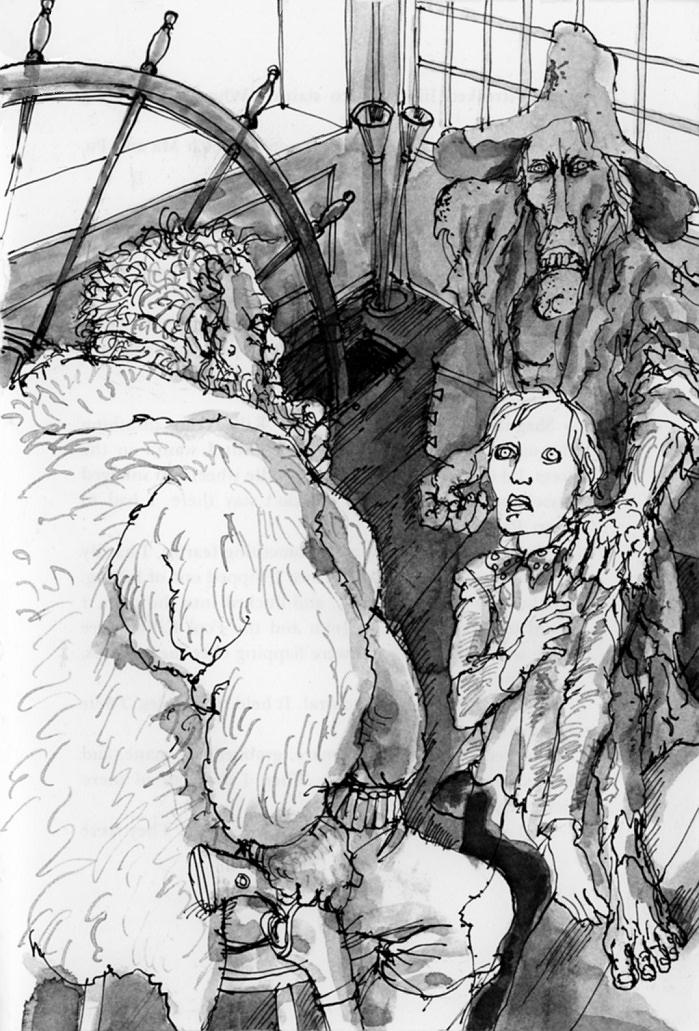
HUMBUG MOUNTAIN by Sid Fleischman 1978 Missouri River steamboat PHOENIX
Humbug Mountain
By Sid Fleischman
Published by Little, Brown and Company
1978
"A young boy and his wandering family foil villains and rout nasty varmints as they make a home for themselves on a beached steamboat on the banks of the Missouri River."
From Page 16:
Ma always talked about Sunrise as if it were our own promised land. It was a brand-new city our grandfather, Captain Tuggle, had staked out somewhere along the Missouri River. That was three years ago. We had a big, rolled-up colored lithograph picture of the town showing Grandpa's very own riverboat, the PHOENIX, tied up at the landing. He'd given us six of the finest lots on a bluff overlooking the hotel and opera house. Someday we'd haul up there and build a great house and Ma could have a piano and plant flowers all over the place. She was always planting gardens, but we were generally up and gone before the flowers were ready to pick. Ma would never let loose of our Sunrise property. Those lots were uncommonly important to her.
From Pages 43 - 44
It wasn't a moment before I cut around the bend and hauled up short. Before me, not fifty yards off, stood a riverboat. It stood sunk and dry on the creek bottom. Mooring lines swung like strands of a great spiderweb from the trees along the bank. Weeds and creepers had grown up through the huge side wheels. I looks at the empty pilot house windows, streaked with dirt. I 'd never seen such a lonely and forlorn boat. You could tell it had once been pluckish and grand; it was fancied up with lacy-cut woodwork. But now the white paint hung in peels and tatter like a snake shedding its skin. . . The crows fluttered down, taking perches like vultures on the crown of the smokestack.
From Pages 56 & 57:
Ma's green eyes wandered sadly from one end of the steamboat to the other.
"The poor old PHOENIX. She was pretty as a duck on the water. But look at her now. Dirty as a pigsty. Grandpa wouldn't allow it. Something dreadful must have happened. He'd never abandon the PHOENIX."
He might be dead, I thought. Maybe we all thought it, but no one ventured to say it.
We trooped across the gangplank to the cabin deck. "Pa said the logbook might tell us a thing or two," I muttered.
Ma nodded. "In Grandpa's stateroom. Or up in the pilothouse."
We opened the cabin doors, one after another, and looked in. It felt as if we were opening tombs. Each stateroom sat in heavy silence, with a red plush chair pulled up to a marble-topped table and rosy light pressing through stained glass at the top of the windows. Grandpa's cabin was far forward and easy to spot. There was a speaking tube hung on the wall, a brass bed, Grandpa's pilot's license framed near the door, and baby pictures of Glorietta and me. There was also one of Ma as a young girl and another of Ma and Pa together.
Still, the room looked ransacked and the bed looked freshly slept in. We didn't find the logbook, but Glorietta discovered a club under the bed. A bur-oak club.
She gave me an anxious glance. No doubt about it, the Fool Killer had been sleeping in Grandpa's brass bed.
Ma opened the window to air out the cabin.
We climbed the stairs to the top deck. The pilothouse sat like a box of windows to the rear of the black smokestacks. But there wasn't a scrap of paper to be found inside. Not even Grandpa's river charts.
Ma shook her head. "What had he been doing, steaming off out of the main river!"
Pages 47 - 48 & 50
The Fool Killer kicked open a door. From inside came a thunderous snort and snoring.
"Shagnasty," the Fool Killer called out.
We were in the pilothouse. I could make out the tall oaken steering wheel, and daylight aglow at the huge windows. Then I saw a man rouse himself from a bedroll on the floor.
"Cuss it all, Fool Killer," he said. "Can't a gentleman take a wink of sleep around here?"
"I catched me another fool," said the Fool Killer.
"Don't look like nothing but a shirttail boy. Set him down."
The Fool Killer kicked the door shut and swung me rightside up. For the first time I got a square look at Mr. Shagnasty. He wore a mangy old bearskin coat and he was big around as a sauerkraut barrel. His beard was dirtbrown and greasy and all a'tangle, like the hairs on a smelly old billy goat.
"Fool Killer," he snorted. "Ain't you got more sense than to bring him aboard? You give away our hideout."
"I spied him cat-footing around."
The other man fixed his eyes on me and hitched up his gunbelt. "Is that a fact?"
"No sir," I said. "I wasn't sneaking about. I was walking plain as day. But I reckon my grandpa's nowhere around, so I'll just be going."
"Well, now, sonny, it's a mite late for that." Mr. Shagnasty pulled out a blue bandanna and gave his lumpy nose a thunderous honk. He wasn't wearing a shirt; just long red underwear, and it was so full of holes you'd think he carried his own moths.
"You know who we are," he said.
I answered quickly, "No sir, I don't."
"'Course you do! Ain't a sheriff anywhere in the territories not looking for the heads of Shagnasty John and the Fool Killer. The terror of the prairies - that's us!"
"I declare," I muttered, struck with awe.
I'd never talked to real outlaws before and I was getting all-over lather of sweat. They were genuine blood-and-thunder badmen.
"I won't tell a perishing soul," I added earnestly. .
The Fool Killer let loose of me to peer out the pilot house windows. I leaped for the door, opened it, banged it shut behind me, and ran like a scared rabbit.

With the exception of images credited to public institutions,
everything on this page is from a private collection.
Please contact Steamboats.com for permission for commercial use.*
All captions provided by Dave Thomson, Steamboats.com primary contributor and historian.
